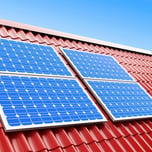
Get up to 4 quotes by filling in only 1 quick form

Slash your energy bills by installing solar panels

We’ve helped over 500,000 homeowners reduce their carbon footprint
- GreenMatch
- Solar Energy
- Solar Panels
- Roof Tiles
Solar Roof Tiles in the UK: Costs, Benefits & More

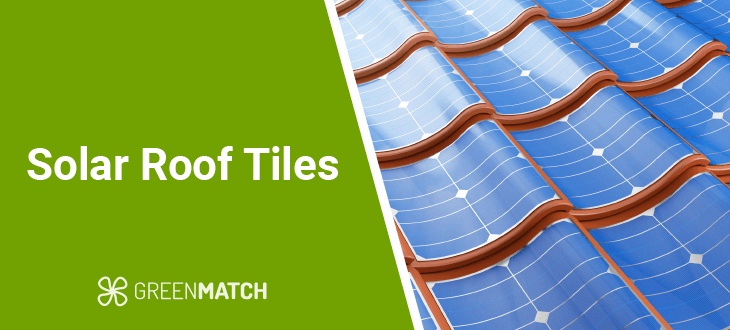
- Solar roof tiles come in a variety of designs and can replace a standard roof, saving you money on electricity.
- Solar tiles can cost between £13,000 and £16,200 for the average home while regular solar panels can cost between £7,000 to £12,000.
- The most popular solar tile providers in the UK are Tesla, GB-Sol, and Solecco.
Solar roof tiles, also known as solar shingles or solar slates, are a relatively new green energy technology. For those committed to sustainable energy generation and wanting to have a solar-powered home, solar roof tiles are worth considering as an alternative to solar panels.
Although solar roof tiles are not widely available in the UK yet, they are moving from being a premium product to a common alternative to “bolt-on” solar panels. The reason is that the technology behind them is becoming increasingly price-competitive and popular. Further in this article, we will cover cost-related matters and list some brands that specialise in solar tiles in the UK. Keep reading to find out more.
Already interested in getting solar roof tiles or solar panels? It all starts with comparing the best quotes on the market. GreenMatch’s services allow you to easily receive up to 4 free, non-binding quotes from trusted local installers that we’ve vetted carefully. No need to waste days on research and calling up companies. Simply click the button below to get started.
- Quotes from local engineers
- Payment by finance available
- Save up to £660 per year
It only takes 30 seconds



What are solar roof tiles?
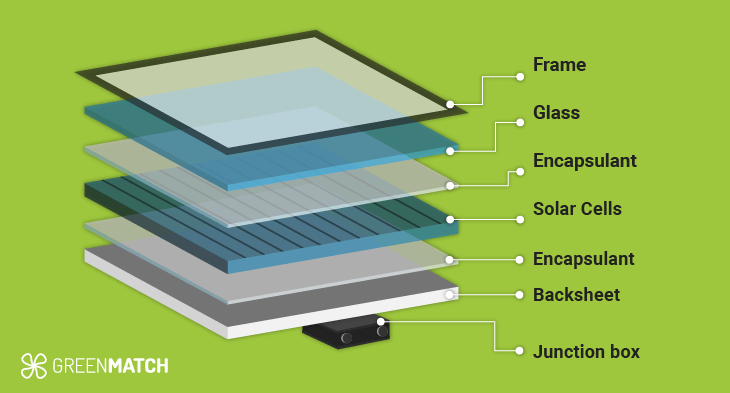
Put simply, solar roof tiles are solar panels that look like roof tiles. They convert energy from the sun and convert it into usable electricity with the help of photovoltaic cells. Much like solar panels, they comprise semi-conducting materials that generate an electric charge and send it to an inverter and eventually a home and/or solar battery.
Unlike bolted-on roof panels, they take the place of the tiling on the roof and become part of the structure of the home. This requires a more complex installation process which takes longer (up to a week) and incurs higher costs than traditional solar panels. However, much like with bolted-on panels, a regional solar panels government scheme can help alleviate some of the costs.
Compared to their counterparts, the distinctive feature of solar roof tiles is their ability to adapt to different styles. This is a significant advantage if you live, for instance, in a heritage area where regulations forbid changes to the buildings. Their finished look is much less aesthetically disruptive than traditional solar panels, as they blend seamlessly with the roof.
Solar or photovoltaic roof tiles are fixed to the position and angle of the roof, which may not always be ideal for optimal sunlight absorption. Like all solar installations, the ideal setup would be on a south-facing roof with a 30° to 50° angle.
The majority of solar roofing installations happen on new roofs, with retrofits being less common. Reroofing and retrofits can be more labour-intensive and companies like Tesla can provide entire solar roofs as opposed to shingles, which are comparatively easier to integrate into new properties.
Solar tiles can be highly resistant and durable. One of the biggest questions consumers have is “Are solar tiles waterproof?”, worrying that a rainy day might penetrate the roof. Most solar tiles are built to be highly resistant to extreme weather and as waterproof as the average roof.
Solar tiles vs solar panels
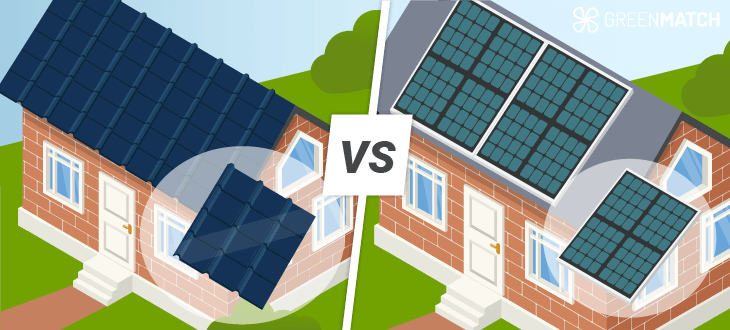
There are many differences between solar roof tiles and solar panels. Let’s go over some of the most crucial ones:
Solar roof tiles:
- Replace the roof tiles: One of the big differences between solar panels and PV roof tiles is the method of installation. The latter replaces the roof while the former rests on it, which means they take longer (upwards of a week) and have higher installation costs.
- Less powerful: They tend to be less powerful per square meter so they take up more space to achieve the same output. Tiles are 10% to 20% efficient, compared to 18% to 25% for regular solar panels.
- Come in a variety of roof designs: Modern solar panel roof tiles come in a variety of shapes and sizes. Some can mimic classic Tuscan roofs while others look like concrete.
- More expensive: Roof tiles are quite expensive compared to standard solar panels and can be quite an investment, often being 30% to even 50% more expensive than standard solar panels.
Solar panels:
- Clamp onto the roof: Solar panels are fitted onto a roof and don’t require drastic alterations. This can make them preferable for some people and thus are more likely to fit hazard requirement regulations.
- More powerful: Solar panels tend to be more powerful than solar roof tiles as they have better efficiencies. This also means they require less space (and fewer panels) for the same power output.
- Harder to visually integrate: Unlike solar roof tiles, solar panels rest on top of the roof and can be visually displeasing.
- More variety: In terms of functionality, the various brands and their models provide a lot of variety to choose from.
- Easier to install: In most circumstances, solar panels are easier to install than tiles, which can mean lower labour costs and easier replacement if needed.
Cost of solar roof tiles
Solar tiles cost between £13,000 and £16,200 for a 2 to 3 bedroom home, requiring a 3kW to 4kW system. The break-even for this type of system would be about 20 to 36 years, assuming the annual electricity savings range between £440 and £660.
The table below illustrates what solar roof tiles cost in the UK. We have also included standard solar panel prices as a reference.
| Solar Roof Tiles UK – Costs | ||||
|---|---|---|---|---|
| System size | Solar tile cost (Inc. VAT) | Labour cost | Total average cost | Regular solar panel cost |
| 1kW | £5,500 – £7,000 | £1,800 | £8,050 | < £5,000 |
| 2kW | £7,000 – £9,000 | £1,900 | £9,900 | £5,000 – £6,000 |
| 3kW | £9,000 – £12,000 | £2,000 | £13,000 | £7,000 – £8,000 |
| 4kW | £10,500 – £16,000 | £2,200 | £16,100 | £9,000 – £10,000 |
The final price depends mainly on the size of the roof and the proportion of the roof you would like to cover with solar slates. You would also have to consider the complexity of the installation process and the installer’s rates. The additional costs can affect the break-even time of your investment.
| Solar tiles vs solar panels savings | ||
|---|---|---|
| System type (3kW – 4kW) | Energy savings | Break-even time |
| Solar tiles | £480 to £700 | 30 to 24 years |
| Solar panels | £480 to £700 | 17 to 14 years |
The installation process for solar roof tiles could take approximately 1 week, though many companies like XO Edge take longer for the full process, which can depend on the process and how customised the tiles are. Moreover, integrating solar tiles into your existing roof is not likely feasible at present. Their installation is more suited to new builds or renovations.
Solar roof tiles might not be an available option for everybody but they are still worth considering for those planning to build a new roof. In some areas, you may need planning permission for such an installation (especially in listed buildings), so it’s important to ask a professional.
If you have decided to install solar roof tiles, solar panels, or any other green energy solution, at GreenMatch, we can help you find the right installer for your home. We will provide you with up to 4 tailor-made offers from professionals near you. Comparing them can help you get the best price and save on installation costs. Get started by clicking the button below.
- Quotes from local engineers
- Payment by finance available
- Save up to £660 per year
It only takes 30 seconds



Types of solar roof shingles
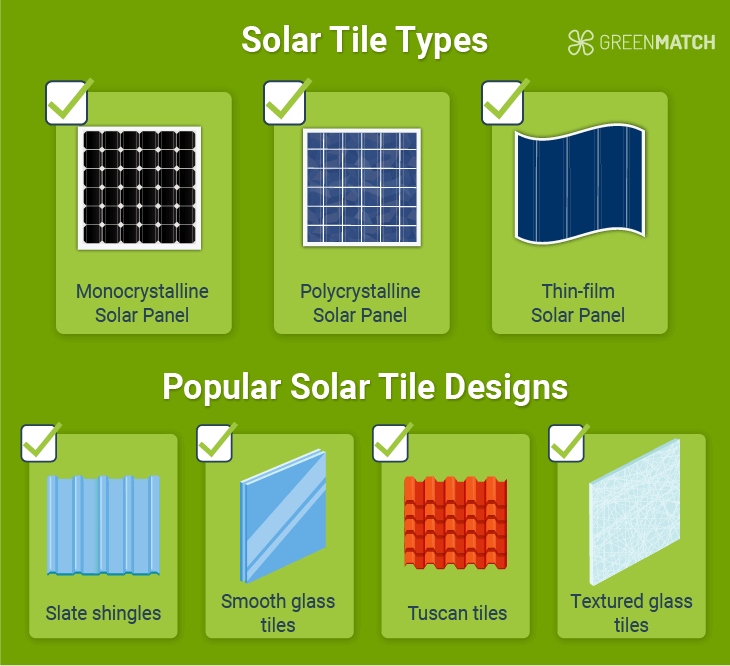
Solar tiles can vary in terms of the different types of solar panels used and the materials they are made of. A solar tile can consist of classic monocrystalline solar cells or thin-film photovoltaic cells. Monocrystalline panels are the most efficient and powerful but cannot be moulded into elaborate shapes.
Thin-film solar cells are budget-friendly, second-generation solar cells. They require less material and are very easy to manufacture. Furthermore, they contain no toxic components and generate less waste. Besides being thin, thin-film solar cells are more flexible and lightweight. These can be moulded into a variety of shapes.
In terms of designs, solar shingles can be Textured, Smooth, Slate, or even Tuscan style, just to name a few. Companies like GB-Sol and Solecco produce solar shingles in the UK and offer them as a discrete alternative to solar panels. Tuscan tiles, like the ones Tesla provides, can bring a more classical look to a home. Alternatively, textured and smooth glass tiles can be manufactured to be indistinguishable from a standard roof.
As of today, thin-film solar cells are less efficient and have lower power capacities than monocrystalline solar cells. However, experts expect thin-film cells to improve in efficiency in the future, as they have a higher theoretical efficiency than monocrystalline silicon cells.
Solar roof tile brands in the UK

The most widely recognised solar tile brand is Tesla’s Solarglass Roof. Tesla solar roof tiles are among some of the most popular. The US-based company is famous for electric cars but also provides novel solar panels, batteries, and tiles.
GB-Sol is a well-known UK manufacturer specialising in highly durable solar panel roof tiles. They have developed their PV Slate, a solar panel roof tile designed to integrate seamlessly with slate roofs, providing an elegant solution for homeowners who value the aesthetics of their roofs. GB Sol manufactures their solar tiles in Wales, ensuring local production and supporting the UK economy.
Looking at the local market, GB Sol offers one of the few solar panel roof tiles already available in the UK. The company designed their PV Slate to integrate with slate roofs. They manufacture the shingles in Wales. Solecco is another great alternative for solar tiles in the UK until Tesla Solarglass is available.
XO Edge produces solar tiles comprised of recycled plastics that have embodied carbon per m2 than conventional tiles and offers efficient solar capture. Thus, the company claims that a large home installation can become carbon-negative (i.e., better off-setting than carbon-neutral) within 6 months. They tout the tile’s aerospace-grade UV resistance and strength.
Solecco is a Leeds-based company that also provides solar tiles designed to blend with various roof types. Their versatile tile colours allow for integration into different architectural styles with a range of finishes. Despite being slightly more expensive than some of their competitors (over £12,000 before labour costs), the company is fairly popular.
Best solar roof tiles in the UK
Here are a few of the best solar roof tiles in the UK:
- GB-Sol solar tiles: GB Sol’s tiles are made for easy and simple integration with slate roofs which allows them to maintain a traditional look. With an aesthetically pleasing design, they can blend in with the design of the roof while also being highly weather-resistant. They are cheaper than a lot of the competition with a 4kW system being nearly £10,500 and offer a 25-year warranty.
- Solecco Solar: Flexibility to adapt to different roof types, providing a customisable solution. High-quality materials for durability and efficient energy generation. Aesthetic options to match the desired look and feel of the roof. Sustainable and environmentally-friendly energy solution. At £12,000, the purchase costs of Solecco are decent, offering multiple colours and designs.
- XO Edge: London-based XO Edge provides ultraviolet-resistant tiles with a sleek black or silver finish. These are some of the lightest tiles on the market and are constructed from recycled plastic that touts aerospace-grade strength.
- Tesla solar tiles: Tesla tiles are popular all across the world. The company also provides one of the best warranties, covering 25 years (the average time till degradation for most solar panels). Their solar roof system comes in several sizes, covering a range of roof sizes and styles, and is best for new homes.
Overall, GB Sol provides the best deal, with a 25-year warranty, weather-resistant tiles with high durability, and a great cost-to-quality ratio. When looking at manufacturers and solar panel warranties, here is some advice from our expert consultant:
“A solar photovoltaic system is a long-term investment. Homeowners should seek warranties for at least 20 years. Most manufacturers offer at least this much with guaranteed power outputs at certain benchmark years. Another consideration for warranties is the ability of a company to pay.”

Joshua M. Pearce is the John M. Thompson Chair in Information Technology and Innovation. He holds appointments at Ivey Business School and the Department of Electrical & Computer Engineering at Western University. He runs the Free Appropriate Sustainability Technology research group.
Advantages of solar tiles for your roof

Domestic solar technologies have many advantages in general, especially in terms of saving energy and protecting the environment. Below, we have listed the main benefits of solar tiles.
- Aesthetically pleasing design: This is likely the most significant advantage of this technology. You won’t have to cover your roof with huge solar panels and, therefore, won’t disrupt your house style. Moreover, there are different types of tiles to accommodate different roof and tile styles.
- Provide clean, free energy: Like solar panels, solar roof tiles are an eco-friendly alternative for powering all your house’s electric appliances. They are also eligible for the same government incentives as solar panels (e.g. the Energy Company Obligation Scheme – ECO4).
- Save on energy bills: Using a solar roof tile system, you can save between 40% and 70% on electricity bills.
- Increase your property’s market value: An aesthetically pleasing look and the current high demand for green energy combined will increase the value of your property.
- Increased resistance and durability: Bolt-on solar panels and solar roof tiles can last decades. However, extreme weather conditions can damage the former. Solar tiles, on the other hand, are often produced to be as durable as the roof itself, and even hurricane-force winds would not rip them off. Solar slates will even protect the roof section they are installed on.
Disadvantages of solar roof tiles
Of course, solar roof tiles have downsides too. Here is an overview of their disadvantages:
- High initial costs: The purchase cost of solar slates is much higher than regular roof tiles. They can be twice as expensive as solar panel systems with similar wattage.
- Less efficient than bolt-on solar panels: On average, solar tiles’ efficiency is 10-20%. Most solar panels have an efficiency of at least 16%, sometimes even 22%.
- Requires replacing current roof tiles: Solar tiles are better for new buildings or those in which all tiles will be replaced. In contrast, traditional solar panels can be installed, uninstalled, and reinstalled fairly easily.
- Not every roof can accommodate them: A roof must be pitched and angled perfectly to be suitable for solar roof tiles. Once again, solar panels are relatively easier to install on ‘difficult’ roofs.
Conclusion: Are solar slates right for my home?
Solar slates can be the right choice if you are looking for a visually appealing option for your home. You will also need a roof with the appropriate angle for absorbing sunlight that faces southward. Solar slates and roof tiles come in a variety of options that can maintain the aesthetics of your home. They integrate into the roof and are made from resistant and durable materials.
On the other hand, tiles can be a more expensive option and are less efficient than bolted-on solar panels. The annual savings range between £440 and £660, so the £13,000 to £16,200 price may not be worth it for everyone if they live in a 2 to 3-bedroom house. However, for some the aesthetics might be worth it or they may live in a conservation area where regular solar panels might disrupt the home’s design.
They are also less efficient than their solar panel counterparts, which means they will take up more space per kW. Solar tiles are also more difficult to install. If these drawbacks do not worry you, solar tiles may be the ideal choice.
Solar panels, on the whole, are more versatile and easier to install. They offer more variety since they have been around longer. Solar panels can also be easier to obtain planning permission for along with having lower installation costs since they bolt onto the roof.
At GreenMatch, we can help you find the best solar energy solution for your home at the best price. Our suppliers will provide you with up to 4 tailor-made quotes, allowing you to compare prices and find the perfect fit for your budget. Just click the button below to get started.
FAQ
While solar roof tiles are not as widely available in the country as solar panels are. A few brands already operating in the UK market are GB Sol, Solecco, and Nulok Roofing System.
Yes, they do. Like solar panels, solar roof tiles are an eco-friendly alternative for powering all your home’s electric appliances. However, they have certain drawbacks compared to solar panels, such as lower efficiency and higher prices.
Some solar roof tiles’ advantages including, an aesthetically pleasing design, high resistance and durability, clean, free energy, eligibility for government incentives, and increasing your property’s value
Solar roof tiles cost in the UK can be twice as much as that of solar panels. On average, you would pay £8,050 for a 1kW system and £16,200 for a 4kW system (including VAT and labour costs).
Solar tiles have quite a few disadvantages compared to solar panels. They can be more expensive, less efficient, and unsuitable for a wider range of roofs.
Solar panels are better than solar tiles in terms of cost, efficiency, and ease of installation. However, solar tiles integrate into roofs better and come in a variety of shapes and designs.

Luis Antonio is a seasoned Content Writer with international journalism experience. His writing style, enriched by a Master’s in Journalism, contributes informative content to GreenMatch on topics including low-carbon heating systems.
 We strive to connect our customers with the right product and supplier. Would you like to be part of GreenMatch?
We strive to connect our customers with the right product and supplier. Would you like to be part of GreenMatch? 




